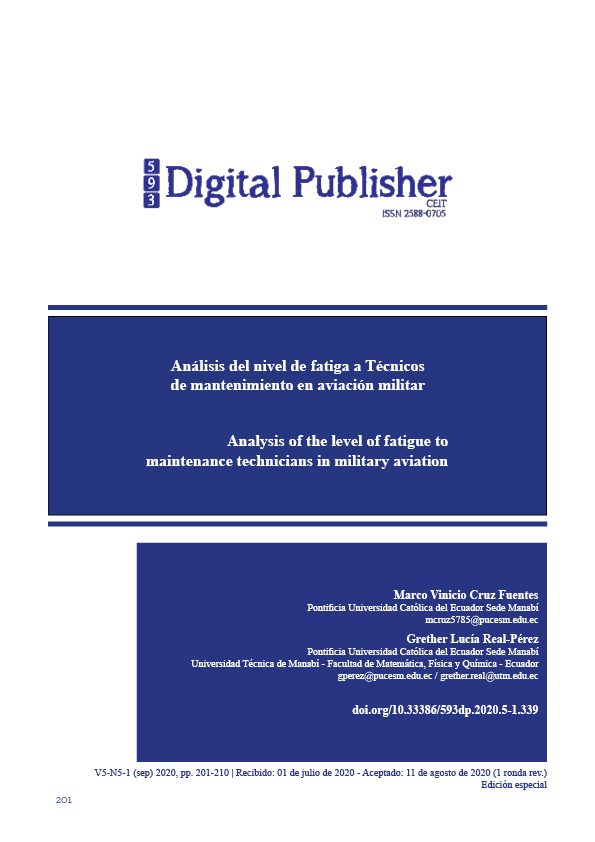Analysis of the level of fatigue to maintenance technicians in military aviation
Main Article Content
Abstract
The purpose of this study through a quantitative, cross-sectional investigation using a Yoshitake test, identifying the levels of fatigue symptoms and their emotional, cognitive and behavioral responses that may have and affect the professional military aviation maintenance technician Able to carry out maintenance activities for airplanes and the military regime, which out of a study population of 40 people, 66% of them present symptoms of moderate to excessive fatigue, which incidence at optimum quality levels in compliance with aviation maintenance processes and aviation safety
Downloads
Article Details
1. Derechos de autor
Las obras que se publican en 593 Digital Publisher CEIT están sujetas a los siguientes términos:
1.1. 593 Digital Publisher CEIT, conserva los derechos patrimoniales (copyright) de las obras publicadas, favorece y permite la reutilización de las mismas bajo la licencia Licencia Creative Commons 4.0 de Reconocimiento-NoComercial-CompartirIgual 4.0, por lo cual se pueden copiar, usar, difundir, transmitir y exponer públicamente, siempre que:
1.1.a. Se cite la autoría y fuente original de su publicación (revista, editorial, URL).
1.1.b. No se usen para fines comerciales u onerosos.
1.1.c. Se mencione la existencia y especificaciones de esta licencia de uso.
References
Ahumada, H., Rodríguez, M., & Ortega, M. (2015). Rotación de turnos, fatiga y transtornos del sueño en un grupo de trabajadores industriales:. Revista cubana de salud y trabajo. Obtenido de http://www.bvs.sld.cu/revistas/rst/vol6_1_05/rst05105.pdf
Boulet,B. (2012). Políticas y costes de mantenimiento de aviones. Instituto tecnológico buenos aires. Obtenido de https://ri.itba.edu.ar/bitstream/handle/123456789/897/pol%c3%adticas%20y%20costos%20de%20mantenimiento%20de%20aviones.pdf?sequence=1&isallowed=y
DGAC. (2010). Rdac parte 001 definiciones y abreviaturas. Obtenido de https://www.aviacioncivil.gob.ec/wp-content/uploads/downloads/2019/06/1.-rdac-parte-00123-mar-10-1.pdf
García., s. (2013). Seguridad aeronáutica y prevención de riesgos laborales y medio ambientales. Obtenido de https://ebookcentral.puce.elogim.com
Hernández, R. (2014). Metodología de la investigación (sexta edición ed.). Mexico.
OACI. (2016). Manual para la supervisión de los enfoques de gestión de la fatiga. Canada. Obtenido de oaci: www.icao.int
OMS. (1948). Official record of the word health organization. Obtenido de https://www.who.int/es/about/who-we-are/frequently-asked-questions#:~:text=%c2%bfc%c3%b3mo%20define%20la%20oms%20la,ausencia%20de%20afecciones%20o%20enfermedades%c2%bb.
Real Pérez, Grether Lucía, Nadima Hassan Marrero, Mercedes Dania Regueira Lezcano, and Argelio Antonio Hidalgo Avila. 2018. “Valoración de Los Regímenes de Trabajo y Descanso. Caso de Estudio: Varadero (Cuba).” Turismo y Sociedad 24(33):149–60.
Redondo, J (2007). Un modelo matemático óptimo de mantenimiento y fiabilidad aplicado a la aviación comercial. E-spacio.uned.es, 30. Recuperado el junio de 2020, de http://e-spacio.uned.es/fez/eserv.php?pid=tesisuned:ingind-jcredondo&dsid=documento1.pdf
Romero Coello, J. (2015). Identificación de los factores de riesgo físico en el centro de mantenimiento de la diaf fae. Repositorio digital. Obtenido de http://www.dspace.uce.edu.ec/handle/25000/5157
Salazar, C., & Del Castillo, S. (2018). Fundamentos básicos de estadística. Obtenido de http://www.dspace.uce.edu.ec/bitstream/25000/13720/3/fundamentos%20b%c3%a1sicos%20de%20estad%c3%adstica-libro.pdf
Sánchez, R., & Lina, M. (2010). El estudio del factor humano en accidentes de aviación. Pensamiento psicológico. Obtenido de http://www.redalyc.org/articulo.oa?id=80113673011
Tovalin, H., Rodríguez, M. &Ortega, (2004). “rotación de turnos, fatiga y alteraciones cognitivas y motrices en un grupo de trabajadores industriales.” Sociedad de ergonomistas de méxico, a.c. Memorias del vi congreso internacional de ergonomía 108–17.
Yoshitake, H. (s.f.). Three characteristic patterns of subjective fatigue symptoms. Doi:10.1080/00140137808931718



